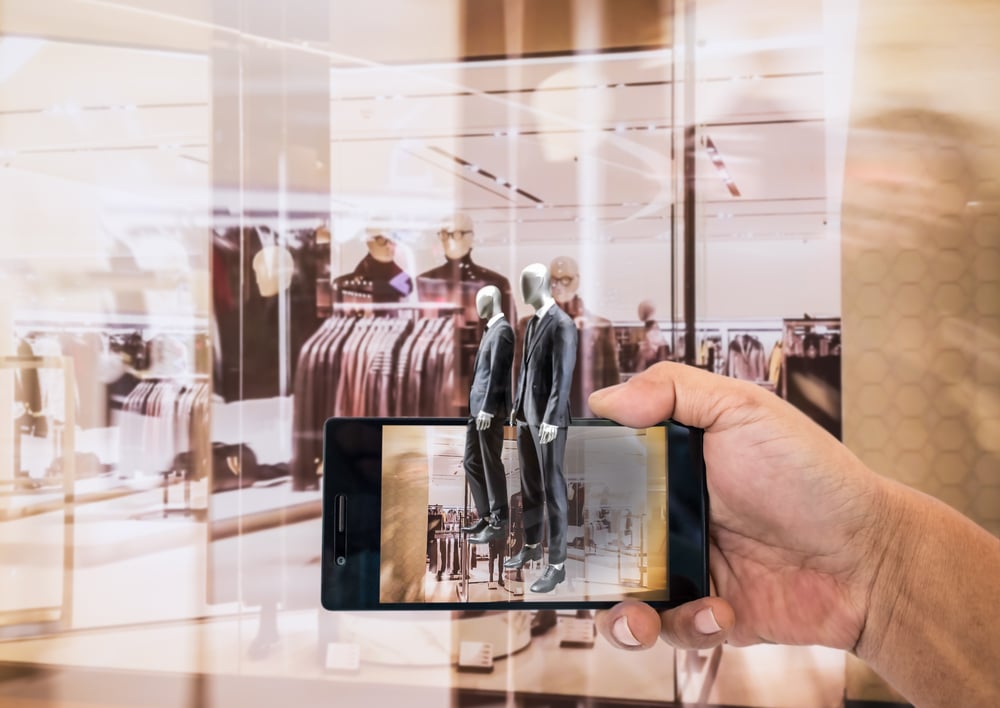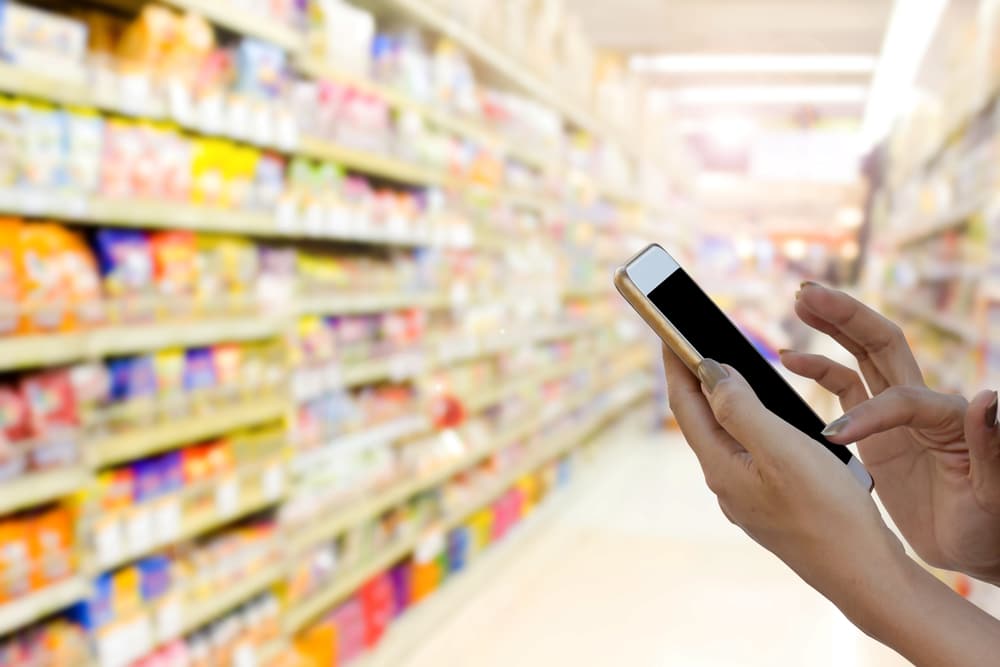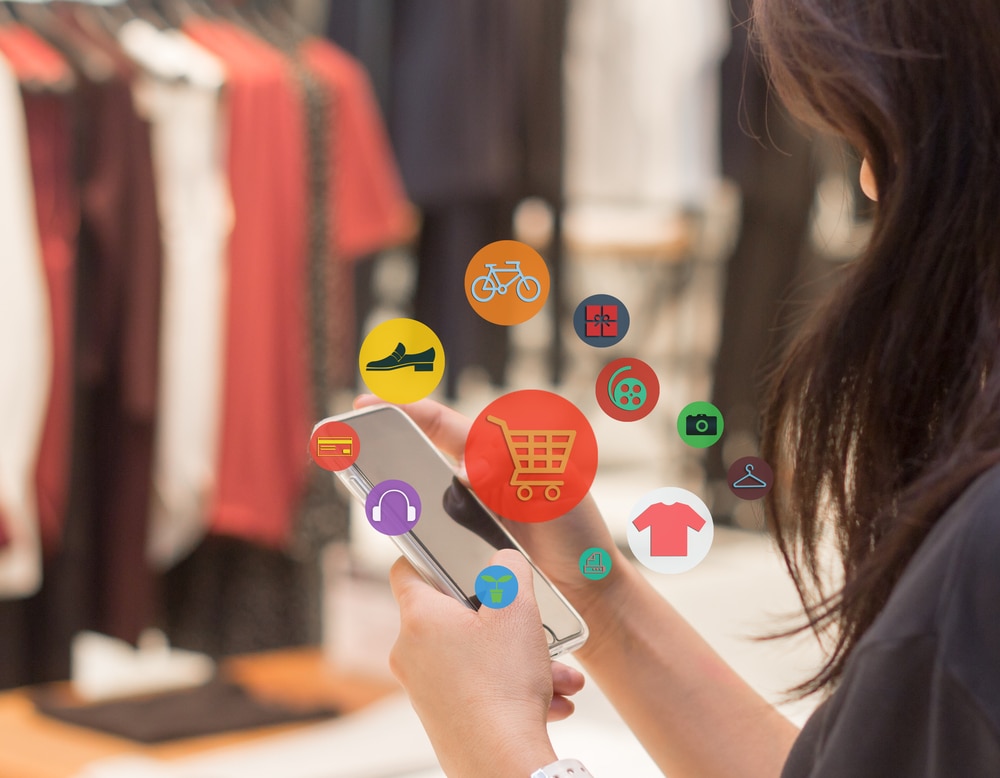CPG brands considering in-app video advertising should be aware of the massive potential that the technology holds. Continue reading “3 ways in-app video advertising can benefit CPG brands”
Category: Marketing
How beacon technology in retail is changing the way brands market to consumers

Though beacon technology in retail has been in use by marketers for years, many haven’t yet realized how intuitive it has become. Continue reading “How beacon technology in retail is changing the way brands market to consumers”
Leveraging location-based augmented reality in retail

Location-based augmented reality is the next iteration of AR in marketing. Continue reading “Leveraging location-based augmented reality in retail”
Understanding the types of consumer buying behavior and ways to influence them

Understanding the types of consumer buying behavior and ways to influence them
CPG brands need to carefully monitor how consumers choose their products to help them stand out among the competition. Approaching these consumers as they’re in the shopping aisle and prepared to make a purchase can be an ideal method. Managing the brand’s online reputation is also critical for differentiating products. With technology, brands can cater to all four types of traditional buying behaviors: impulse, habitual, dissonance reducing, and complex.
The Types of Consumer Buying Behavior and Their Impact on CPG Brands
There is a basic model of human buying behavior established by Henry Assael, professor of marketing for NYU Stern. Assael broke down the consumer buying models according to consumer knowledge of products and the difference between brands. These categories break down as follows:
Variety-seeking:
Consumers may enjoy reading about and trying new brands and will often make decisions to try new products impulsively. There’s very little time between product discovery and purchase. The consumer isn’t switching brands due to dissatisfaction, but simply because they want to try something new. Variety seeking is a substantial area of opportunity for CPG brands as CPG goods are typically priced lower than others, posing a low risk for consumers.
Habitual buying:
Consumers stick to brands they know as they see little difference between products. Habitual buying challenges CPG brands when that loyalty is to a competitor, as it can be very difficult to pull the consumer away from the products they trust. The brand must be able to differentiate its products from the competitors to win consumer attention.
Dissonance reducing:
There may be very little difference between the products available across various brands, but consumers may still choose to do extensive research. This research may stem from dissatisfaction with the product itself. Alternatively, this information gathering may come as a result of increased social awareness about the impacts of manufacturing. In either case, brands must invest in products and overall reputation to connect with these shoppers.
Complex buying:
Consumers who do extensive research before buying may have little familiarity with the brands and choices available. This buying behavior is typical when making big-ticket purchases, but that does not mean it’s not a concern for CPG brands with lower price points. Complex does not have to mean costly. It can also occur when a consumer has a concern over a product’s impact on their well-being, like in the case of health and beauty products with unfamiliar ingredients.
Using Mobile Shopping Apps to Excite Variety-Seeking Consumers
Variety-seeking consumers are promising prospects for CPG brands as they’re open to trying new products. While they may not extensively research before making a purchase, digital marketing still makes an impact. Timely promotions delivered via mobile shopping apps can provide excellent ROI for impulse buying behaviors. Such messages target these consumers based on their location and drive them to interact with products. We see an example of this through Shopkick and how consumers use the shopping app.
Notifying:
The first step to securing a purchase is brand awareness. With Shopkick, a timely notification lets the consumer know which products in the store offer kicks (aka rewards points) and how many. The alert makes the consumer aware of the brand and encourages them to seek it out.
Priming:
When a consumer physically handles a product, it establishes a sense of ownership. Shopkick encourages consumers to pick up products by offering incentives for scanned UPCs. The moment a consumer touches the product, the chance of purchase increases.
Incentivizing:
Shopkick users receive rewards points when they locate certain products in the store, and even more points when they purchase them. By rewarding purchase path behaviors both in-aisle and through checkout, brands create customer affinity and increase sales potential.
Gamification:
The entire process works as a digital scavenger hunt with various goals and rewards. Shopkick’s design turns an everyday shopping trip into an enhanced customer experience. This gamification improves the use and retention of the app, which expands the brand’s audience.
Cultivating Habitual Buying Through Data-Driven Personalization
Customer loyalty is entirely relationship-driven. Brands wishing to pull loyal customers from competitors, while also growing their faithful following, should look to personalization to establish these relationships. Profiles created with existing consumer data aid in this process by helping brands deliver personal messages on a mass scale.
Any time a brand uses data, consumer privacy must be a concern. If a consumer feels their personal information is unsafe, there’s a risk of alienating them. However, consumers are receptive to data use for personalization, and consider value the number one driver of trust. As long as their data is used to provide them with a heightened experience, consumers are willing to share it.
Attracting Dissonance-Reducing Buyers With Online Reputation Management
Dissonance-reducing consumers are researchers who are well-informed about products. Differentiative marketing is critical as this buying often occurs in the CPG market, where branded products are similar to those of their competitors. Brands may not be able to rely on their product but instead must focus on their overall reputation to stand out.
How Video Marketing Supports Complex Buying
When consumers make complex buying decisions, they’re often at a disadvantage. They know they need to do significant research but may not be familiar with the product. A typical example of complex buying is car purchasing. Consumers may not understand the differences between several different options and will turn to the digital space to learn more about them. However, CPG brands need to stay on top of this buying behavior as well, because it can impact lower-cost, mass-produced items.
Catering to complex buyers requires a simplified approach. Explainer videos are ideal as they allow a brand to share information about a product while making those details easy to digest for the consumer. In some cases, they can drive the success of a debut product.
The 3 best retail marketing strategies for CPG brands to utilize in the new year

Brands seeking the best retail marketing strategies for 2019 should consider how technology may have changed product visibility. Continue reading “The 3 best retail marketing strategies for CPG brands to utilize in the new year”
Successful brand repositioning examples designed to reach a greater consumer audience

Successful brand repositioning examples designed to reach a greater consumer audience
Reputation management is often a challenge for brands. If a brand has established itself as a big business, consumers may write them off as impersonal. A personal connection is what allows smaller challenger brands to take market share from their established competitors. By focusing on connecting with consumers, brands of any size can reposition themselves in the marketplace both online and in the shopping aisle.
Successful Brand Repositioning Example #1: Campbell’s Bets on Transparency
Consumers want transparency from brands. Specifically, 94% of consumers report they would remain loyal to brands with transparent principles. Keeping all business practices open isn’t easy for large brands, but Campbell’s managed this to do so leveraging the digital space.
Successful Brand Repositioning Example #2: Hallmark Trades on Brand Equity
Hallmark serves as an excellent example of brand endurance in a changing market. The brand has been around for more than a century and has seen significant paradigm shifts from its early days as a simple greeting card company, to its current status as a multi-brand conglomerate. In 2014, Hallmark’s movie channel was floundering. They chose to reposition it to reach more consumers by changing the tagline and adding a new focus: mysteries.
Successful Brand Repositioning Example #3: CoverGirl Updates Its Tagline
In 2017, CoverGirl faced shifting attitudes in the cosmetics industry. No longer just an everyday product for women, some consumers began using cosmetics as a means of self-expression. The 60-year-old “Easy, Breezy, Beautiful” tagline didn’t do enough to reach the growing pool of diverse consumers. As such, the brand shifted its focus with a new tagline: “I Am What I Make Up.”
Successful Brand Repositioning Example #4: Clorox Targets Aggressive Growth
Many brands failed to make the transition to digital because they became too comfortable with the status quo. These brands had successful products and loyal users. However, even the simplest of products need reinvigoration to stay relevant. Leaders of the Clorox brand understand and embrace the need to innovate, even with items as basic as household cleaners. It’s recent “2020 Strategy” is a three-pronged approach which combines:
Co-branded product development:
One way that Clorox expanded its presence was by collaborating on products with other well-known brands. A few examples of these strategies include Clorox with Scentiva and Fresh Step cat litter with Febreze. By combining brands, Clorox created awareness across multiple markets and solidified their overall household product lead.
Digital advertising initiatives:
Almost half of Clorox’s marketing budget goes to digital initiatives designed to increase online awareness. So far, online sales bring in only 5% of the brand’s revenue, but it’s also the fastest growing segment for sales. The brand’s efforts to expand online marketing have helped it gain a greater e-commerce foothold which will drive sales in years to come.
Brand equity investment:
Clorox has the benefit of strong brand equity. This equity is critical in household goods, where consumers tend to stay loyal. The brand reported reaching two million new households in 2017. This result indicates that the focus on staying true to the Clorox brand through integrated marketing strategies is paying off.
Successful Brand Repositioning Example #5: Walmart Uses Digital Initiatives in Stores
Brick-and-mortar retailers faced challenging times when the internet turned into the source for all products, even lower cost CPG items. However, Walmart didn’t abandon its brick-and-mortar locations to focus entirely on digital sales. Instead, it tied the digital and physical together through its mobile initiatives. The brand focused on convenience features for consumers such as:
Store maps:
The retailer offers an option to view location maps to find items at its stores easily. New maps are added regularly, as they have more than 4,600 locations to digitize. Through digital mapping, the brand improves the customer experience while limiting work for associates.
List building:
Consumers can create an in-store shopping list to better budget their time and their grocery money. They can gain information on product deals and discounts and easily locate in-stock items across various locations.
Third-party app partnerships:
Partnering with third-party app developers like Shopkick allows Walmart to reach new audiences who don’t typically use the retailer’s proprietary apps. It also expands the kinds of apps the retailer can offer, as consumers may use several shopping apps while in the store or online.
Specialty department integration:
Consumers can get details on Walmart Photo Centers, Auto Care Centers, and Pharmacies. They can also review availability for Rug Doctor rentals. This integration serves to cross-market these niche businesses within the store ecosystem.
Successful Brand Repositioning Example #6: Amazon Embraces Shopping Innovations
When compared to other examples, Amazon is a young company. However, that youth doesn’t trump its need to innovate. Amazon, through the development of its smart speaker and Alexa digital assistant, has disrupted the industry by creating a new means of online shopping: voice ordering. The retailer also partnered with the popular social media platform Snapchat to take advantage of image-based search.
The voice ordering market has been slow to take off, but it’s rife with potential. Smart speakers have not fully penetrated US households. As they do, voice ordering is expected to explode in value. The industry could account for up to $40 billion in sales by 2022. Amazon, being the primary purveyor of smart speakers, is set to profit exponentially from this trend.
Successful Brand Repositioning Example #7: Bloomin’ Brands Integrates Rewards
Customer loyalty programs are nothing new in regard to hospitality. However, integrated programs that allow consumers to dine at a variety of locations are. Bloomin’ Brands, the parent company of Bonefish Grill, Outback Steakhouse, Carrabba’s Italian Grill, and Fleming’s Prime Steakhouse & Wine Barn offers consumers a consolidated rewards program.
The company doesn’t just use the loyalty program to drive visits. Instead, their focus on servicing the 4.6 million users of the app is to gain data. Through it, the brand can discover what encourages consumers to visit specific locations. They can also use this information to guide future marketing initiatives and keep members alerted to promotions.
How the best marketing trends of 2018 will impact brand retention in the coming year

Marketing trends in 2018 were heavily focused on the new options created through updated technology, and this will continue to shape the industry through 2019. Continue reading “How the best marketing trends of 2018 will impact brand retention in the coming year”
A chat with CEO Adam Sand: 2019 marketing technology predictions

As 2018 comes to a close, marketers are gearing up for what’s to come in the new year. We sat down with Shopkick CEO Adam Sand to discuss his marketing tech predictions for 2019 – the exciting opportunities that lay ahead, the biggest challenges that marketers will face, and more.
Challenges to come:
- Physical stores transform into consumer destinations: With in-store foot traffic continuing to decrease year-over-year, retailers need to find new ways to drive shoppers through the doors. 2019 will see brick and mortar stores rapidly trying to reinvent themselves as a destination and physical escape for consumers.
- Going beyond location: While location based advertising has grown tremendously, marketers are still struggling to dig deeper and learn more about their consumers beyond their physical location. In 2019, marketers will search for richer data to reach the right mobile consumer.
- Consumer privacy laws: The next year may not see major changes in privacy laws, but the reality is surely on the horizon in the years that will follow. In 2019, companies will begin making precautionary changes and determine how they’ll function moving forward.
Challenges that will ease up:
- Personalization: 2019 will see an increase in fun, personalized mobile engagements. Little by little, mobile experiences will become more targeted as data on the individual consumer becomes more and more rich.
- Serving the right message at the right time: Consumer data including location, shopping history, and purchase history on both an item and store level will allow marketers to more effectively serve shoppers the right message, at the right time.
- Leveraging video through the consumer journey: The more that marketers know about their consumers, the easier it will become to reach shoppers with video at the right moments along their purchase journey.
Exciting opportunities ahead:
- Computer vision dominates as ultimate search tool: The advancements in visual search and increasingly intelligent smartphone camera technology will enable shoppers to access product-level details and comparison shop while in the aisle.
- Item-level purchase data will be the Holy Grail: This specific product information will reshape the way companies structure their loyalty programs.
- Marketers will take a stand: As consumers increasingly use their wallets to make a political statement, brands and retailers will identify and use their voice to attract more business.
Shopkick offers our partners the opportunity to connect with consumers in the shopping aisle while incentivizing interactions with a fun rewards program. To use our program to boost your results in the new year, contact us.
The path to purchase: How your brand can guide consumers in the right direction

Guiding consumers along the path to purchase with in-store advertising is one of the most effective ways to improve in-store sales. Continue reading “The path to purchase: How your brand can guide consumers in the right direction”
How mobile is influencing the future of visual merchandising

Retail image recognition technology will profoundly impact the future of visual merchandising as it will have the potential to convert everyday interactions into a sale. Continue reading “How mobile is influencing the future of visual merchandising”
Why understanding consumer behavior is one of the best things your company can do

Understanding consumer behavior helps brands create impactful marketing campaigns which improve sales. Continue reading “Why understanding consumer behavior is one of the best things your company can do”
A successful rebranding strategy needs these key elements to gain consumer attention

A successful rebranding strategy needs these key elements to gain consumer attention
Additionally, consumers’ purchase behaviors will change over time. New purchase platforms will require new strategies, while old ones may become obsolete. The mobile commerce trends that impacted the CPG industry through 2018 were all centered on this technology shift. Consumers began spending more time on their mobile devices, and brands had to shift avenues to reach them. Moving to a mobile-first strategy often requires rebranding to ensure the new medium accurately translates the brand’s messages.
Staying Up-to-Date on Demographic Desires by Generation
While it’s important not to stereotype consumers, there are some purchase behaviors that seem common amongst certain demographics. This is especially true during such diverse times as these, where some individuals grew up with the internet while others discovered it as young adults. This disparity will impact how likely these individuals are to adopt new technology. There are four generations in the marketplace which will make the greatest impact on a brand’s bottom line;
Boomers:
Baby Boomers make up the oldest generation of shoppers, and are typically already retired or close to retirement. Brands may incorrectly assume these individuals are not internet savvy, but this couldn’t be further from the truth. While boomers prefer to shop in-store, they’re also a vocal presence online. Social media is an important channel, as 71% of boomers report having a profile on a social media site.
Generation X:
Generation X is a smaller generation, represented by those born between the mid-1960s and the early 80s. These individuals are comfortable with the internet, but also enjoy more forms of retro-entertainment as well. They place high value on the opinion of their peers, as 21% of Gen X’ers report making purchase decisions based on a personal recommendation, while 19% rely on online reviews.
Millennials:
Millennials are a major market of opportunity, being as large as the Boomer market. The millennial generation is represented by those born between the mid-80s and the late 90s. While they grew up with the internet, the majority of these consumers still prefer to do their shopping offline. When marketing to Millennials, brands may want to consider establishing mobile marketing strategies to aid in the in-store experience.
Generation Z:
Generation Z is made up of those born after the turn of the century. This generation will play a large role in the future of retail, as they are on their way to being of age to make purchase decisions for themselves. In fact, by the year 2020, they’ll be the largest generation of consumers by size.
Regaining Relevance With a New Market of Consumers
Today, one of the most difficult places to stay relevant in is the apparel industry. Trends change quickly in fashion and even iconic brands may find themselves floundering. This was the case for the well-known denim brand, Levi’s, as a sudden sales slump caused them to adopt a rebranding strategy.
Levi’s held the top spot when it came to denim in the U.S., hitting $7.1 billion in annual sales during its peak in 1996. However, as their target demographic grew up and spent less on denim, Levi’s brand equity wasn’t enough to attract the younger Millennial market that replaced them. These shoppers typically preferred designer names over affordability when it came to jeans, meaning Levi’s had to discover a way to appeal to younger consumers. The brand took several crucial steps in its rebranding strategy.
Influencer partnerships:
Levi’s was hit hard by the rise of fashionable athletic wear, so they had to reach out to influencers that wore this type of clothing while also creating a higher-end feel. Kim Kardashian famously debuted the brand’s RE/DONE line, while Levi’s jeans were also heavily featured on the family’s widely anticipated 2017 Christmas card. As the Kardashian-Jenner family is typically glamorous and fashion-forward, the casual look adopted for the card helped pull more interest to the brand.
Strategic collaborations:
Levi’s has also worked with a number of innovative companies in developing digital campaigns and initiatives. Levi’s partnered with Disney for a Snapchat promotion and worked with Google to develop a functional, fashionable smart jacket. These innovative campaigns gained the attention of younger Gen Z consumers who find innovation in unexpected places very appealing.
Social responsibility:
Consumers are demanding more social accountability from companies, especially those in the apparel industry, and Levi’s listened. The company made a pledge to reduce its water use and did so with a new protocol which allows them to reduce water consumption in the denim finishing process by 96%.
Using Digital Avenues to Connect With Consumers
One takeaway that the studies of various demographics have shown us is that brick-and-mortar shopping is thriving. Across all demographics, consumers prefer shopping in the store when they can. However, the need for digital advertising is still critical in order to reach them.
Mobile app partnerships can help brands get in front of the right consumers at the right time. These strategies can also work to direct consumers to products in the store. Shopkick is heavily focused on using mobile technology to aid consumers as they shop and has built functionality in its app to best leverage this.
Using Innovative Shopping Options in a Rebranding Strategy
The window from early adoption to mainstream use of technology is surprisingly narrow. This can be seen through studying the timeline of the smartphone. The first smartphone device designed for widespread consumer use—the iPhone—debuted in 2007. As of 2017, nearly 70% of the American public had a smartphone. In less than a decade, smartphones went from being cost-prohibitive, technical devices in use by few to widely available, affordable options used by just about everyone. Therefore, it’s reasonable to believe that technologies in the early adopter stage now will expand to mainstream use over the next decade. Some technologies to consider include:
2D image recognition:
Image recognition technology is expected to impact retail by allowing consumers to shop based on their everyday experiences. For example, a consumer could take a photo of a shirt someone else is wearing, upload that photo, and receive information on where to purchase it online. Snapchat and Amazon have already taken advantage of this technology. The companies teamed up to offer Snapchat users the option to find items on Amazon by uploading photos of the products they see.
Voice ordering:
Smart speakers will drive the adoption of voice ordering. Almost one-third of U.S. households have a smart speaker and that number is expected to rise. While voice ordering hasn’t grown as fast as initially expected, mainstream use of such devices will likely change that. As consumers become more comfortable with the technology, they’ll use more of its available features.
Augmented and virtual reality:
Apps that provide an immersive experience for consumers act as an excellent way to refresh a brand’s image. Many popular retailers, including Target and Amazon, have created AR apps to make shopping online easier for consumers.
Location-based apps:
Reaching consumers as they’re passing a restaurant or in the shopping aisle can increase the likelihood of sales. Geo-tracking, GPS, and beacons help tell brands where consumers are in their shopping journey and guide them to their products. These are common technologies for today’s retailers and it’s likely they will grow even more complex over time.
Brands that want to update their reputation can do so by taking advantage of innovation. Offering a new, in-demand experience revitalizes a brand and makes it appear tech-forward. In many cases, brands will not have to invest significant funds in creating these innovative experiences. Instead, they will need to establish third-party partnerships with shopping and social media platforms.
Brands should consider adopting a rebranding strategy at some point if they want to stay relevant with consumers. Understanding how the desires of their target demographics will change is the first step. Following that, brands need to align themselves with today’s consumers and take advantage of the technology they use to make purchase decisions. With a tech-forward approach, brands can preserve their name equity and improve sales online and in the store.

